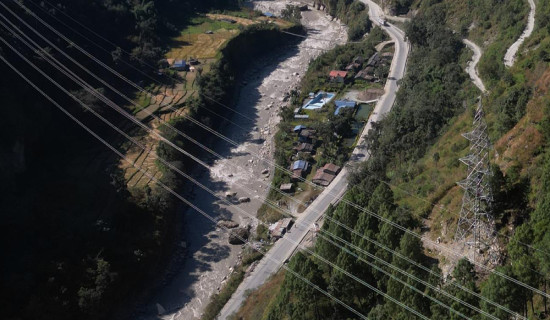- Tuesday, 2 December 2025
Protecting rhinos from tiger attacks challenging
By Basanta Parajuli,Sauraha, July 26: Three baby rhinoceroses are currently growing up at the National Trust for Nature Conservation (NTNC) located in the tourist town of Sauraha, Chitwan.
A one-month-old male calf was rescued from the Baghmara Community Forest area on July 6, followed by a one-and-a-half-month-old male calf found on July 17 from Belshahr Community Forest, Devnagar, and a one-month-old female calf rescued from the Khorsor area near Sauraha on November 2, 2022. These calves are now being raised on the premises of NTNC Chitwan.
All the baby rhinos were found injured by tigers and are currently being treated in Chitwan National Park (CNP), according to Dr. Bijay Shrestha, a senior veterinarian at CNP.
"Ram, the baby rhino found in Baghmara, Dev from Devnagar, and Pooja found near Khorsor are now being treated in cages. Pooja has grown up, and her wounds have healed, while Ram and Dev are still undergoing treatment,” he added.
Ram, Dev, and Pooja are just a few examples of rhinoceros babies injured in tiger attacks, which seem to have increased recently.
Ganesh Tiwari, the information officer and assistant conservation officer of the park, reported that six out of the 22 rhinos that died in the fiscal year 2022/2023 were attacked by tigers.
Similarly, in the years 2021/2022, 2020/2021, 2019/2020, 2018/2019, 2017/2018, and 2016/2018, six, one, one, two, four, and two deaths, respectively, were attributed to tiger attacks.
Wildlife expert Dr. Baburam Lamichhane stated that the increase in the number of tigers has led to a rise in baby rhino killings. "As the number of tigers increases, so does their need for prey. Unfortunately, baby rhinoceroses have become their victims of choice," he added, emphasizing that there are ways to reduce such incidents.
Around 12 years ago, at the international conference on tigers held in Saint Petersburg, Russia, Nepal pledged to double the number of tigers by 2022. According to the statistics from the tiger census in 2022, the number of tigers has indeed increased, and the target has been met.
Prior to the 2010 tiger convention in St. Petersburg, Nepal was home to 121 tigers. Now, the number has increased to 355, with tigers found in five national parks in Nepal: Chitwan, Parsa, Bardia, Banke, and Shuklaphata National Parks. Chitwan alone has seen an increase from 60 tigers in 2000 to 128 tigers in 2022.
Dr. Lamichhane, an expert in tigers, highlighted that with the growing tiger population, challenges related to habitat, food, and conservation have also increased. "As the tiger's natural prey species like deer, blue cow, and Bos Gaurus have declined, they have turned to rhinoceroses as an alternative," he explained.
Covering an area of 952 square kilometres, CNP boasts the largest number of tigers in Nepal. According to a survey, there are about 99.7 tigers per square kilometre in Chitwan. While the tiger's main prey include deer, wild boar, and spotted deer, their food sources have not kept up with their needs, especially due to the erosion of the park, which has led to a decrease in grasslands.
Ecologist Naresh Subedi, the director of NTNC, who has studied the ecosystem of rhinos in Chitwan, acknowledged that it's natural for tigers to eat rhino babies when their numbers increase. He stressed the need to focus on increasing the populations of tigers, blue cows, and Bos Gaurus, which are large prey animals for the tigers. "If we can ensure an ample supply of alternative prey for tigers, the hunting of rhinoceroses may be reduced,” he suggested.

















